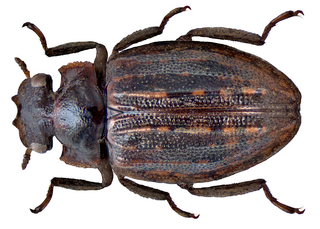
Spercheus is a genus of aquatic beetles which are placed in a family of their own, Spercheidae within the Hydrophiloidea. About 20 species are known from around the world except the Nearctic with the majority being from the Oriental and Afrotropical Realms.

Hydrophilidae, also known colloquially as water scavenger beetles, is a family of beetles. Aquatic hydrophilids are notable for their long maxillary palps, which are longer than their antennae. Several of the former subfamilies of Hydrophilidae have recently been removed and elevated to family rank; Epimetopidae, Georissidae, Helophoridae, Hydrochidae, and Spercheidae. While the majority of hydrophilids are aquatic, around a third of described species are terrestrial, mostly belonging to the subfamily Sphaeridiinae.

Hydraenidae is a family of very small aquatic beetles, sometimes called "Minute moss beetles", with a worldwide distribution. They are around 0.8 to 3.3 mm in length. The adults store air on the underside of the body as well as beneath the elytra which allows them to crawl underwater, often on the underside of the water surface tension, though they cannot swim. Some species have gills that effectively allow them to stay underwater indefinitely. Larvae vary from being fully terrestrial, to being aquatic at least in their earliest instars. The diet of hydraenid larvae and adults is thought to consist of algae, spores and other plant matter. At least some hydraenid adults use stridulation to communicate. There are around 1,300 species in 42 genera.

Hydrochus is the only living genus of beetle in the family Hydrochidae, which belongs to the superfamily Hydrophiloidea, and was formerly treated as a subfamily of Hydrophilidae. Hydrochus includes about 180 species, which are found worldwide. The name "Hydrochus" has also been used for a fly genus in the family Dolichopodidae, but this is a junior subjective synonym of the genus Rhaphium.

Hygrobia is a genus of aquatic beetles native to Europe, North Africa, China and Australia. It is the only genus in the family Hygrobiidae, also known as the Paelobiidae. These are known commonly as squeak beetles or screech-beetles.
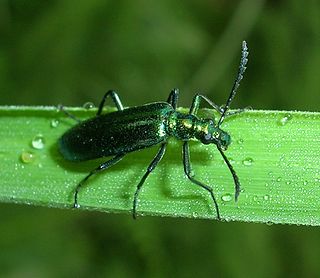
Prionoceridae is a small family of beetles, in the suborder Polyphaga. They form a group within the cleroid beetles and were formerly treated as a subfamily (Prionocerinae) within the family Melyridae. Very little is known of their life history but most species are pollen feeders as adults and occur in large numbers during spring or the host flowering season. Larvae are predatory or feed on decomposing wood.
Zulubuprestis is a monotypic genus of beetles in the family Buprestidae, the jewel beetles. The sole species is Zulubuprestis reliquia. It is known only from South Africa.
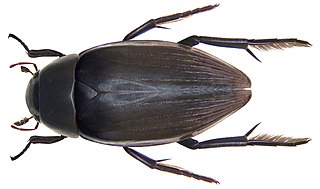
Hydrophilus is a genus of beetles in the family Hydrophilidae, the water scavenger beetles. There are 53 species in three subgenera in the genus: Hydrophilus, Dibolocelus, and Temnopterus.

Copelatus sociennus is a species of diving beetle. It is part of the subfamily Copelatinae in the family Dytiscidae. It was described by J. Balfour-Browne in 1952. The species can be found on Coloane and in Seac Pai Van. It feeds on Nelumbo nucifera.

Ancyronyx, commonly known as spider water beetles or spider riffle beetles, is a genus of aquatic riffle beetles from North America, South Asia, China, and Southeast Asia. They are small beetles with extremely long legs ending in strong claws. Both the adults and the larvae are found underwater in the shallow riffles of streams and rivers, clinging to rocks or submerged wood. They feed on algae and decaying wood tissue. The genus contains twenty-one species, eleven of which are endemic to the Philippines.

Helobata is a mostly Neotropical genus of water scavenger beetle in the family Hydrophilidae. It contains 13 described species, one of which is broadly distributed, reaching North America.

Ochthebiinae is a subfamily of minute moss beetles in the family Hydraenidae. There are about 14 genera and more than 650 described species in Ochthebiinae.
Goniusa is a genus of rove beetles in the family Staphylinidae. There are at least three described species in Goniusa.

Ochthebius is a genus of minute moss beetles in the family Hydraenidae. There are at least 460 described species in Ochthebius.
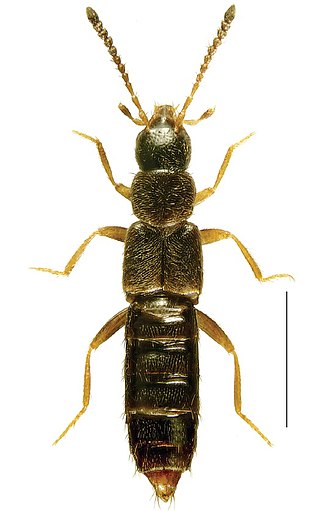
Halobrecta is a genus of rove beetles in the family Staphylinidae. There are about six described species in Halobrecta.
Gymnochthebius is a genus of minute moss beetles in the family Hydraenidae. There are more than 60 described species in Gymnochthebius.
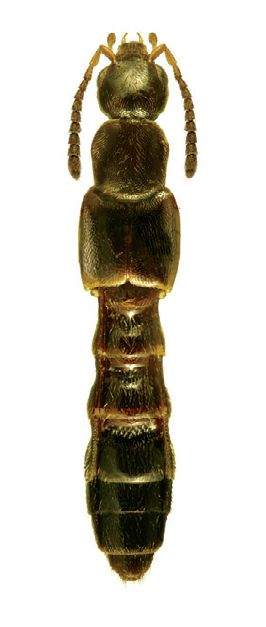
Tachyusa americana is a species of rove beetle in the family Staphylinidae. It is found in North America.
Ancyronyx jaechi is a species of riffle beetle found in Sri Lanka.
Hydrovatus rufoniger, is a species of predaceous diving beetle found in India, Bangladesh, Myanmar, Sri Lanka, China, Sumatra, Malaysia, Singapore, Thailand, Vietnam and Australian region.
Hydrovatus lyratus, is a species of predaceous diving beetle widespread in South Asia, South East Asia and Australian region.













